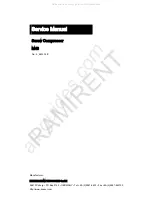
5 Testing & Troubleshooting
19
5.3 Electrical Fault Diagnosis
The following describes an effective procedure for tracing an electrical fault in a CKMTA12 or
CKMTA24 compressor which has been wired using a genuine ARB wiring loom (refer to the
diagram in Figure 9.). All steps must be performed in the order listed here for an accurate
assessment.
NOTE : Before attempting to troubleshoot a malfunctioning compressor, always
make sure that the compressor manifold, air tanks and connected
accessories have been de-pressurized, all connections have been made
according to the wiring diagram, the vehicle’s ignition is in the ACC power
position, and that the ISOLATING SWITCH has been turned ‘ON’.
NOTE :
The ‘MOTOR VOLTAGE’ referred to below should be approximately 12V in
the case of the CKMTA12 and 24V in the case of the CKMTA24. Otherwise
‘12V’ refers to approximately 12V regardless of compressor model as the
24V compressor runs on a 12V control circuit.
NOTE : Battery number references (e.g., [#1]) are for 24V system wiring purposes.
S T E P #
1
Using a multimeter, check the voltage at the battery terminals to make sure the battery
is working and is fully charged. Check each individual 12V battery in a 24V system.
Did each battery measure at least 12.5 volts?
YES
Proceed to STEP 2.
NO
Insufficient battery voltage. Recharge or replace the battery.
2
Disconnect the compressor motors from the wiring loom at the connector plugs. Run a
new wire directly from the negative (-) terminal of the battery [#1] to the BLK-WHT wire
of the one compressor motor. Momentarily connect a wire from the positive terminal of
the battery [#2] to the RED wire of the same compressor motor. Repeat for the second
motor.
Did the compressor activate when the wires were connected?
YES
Remove the extra wires and reconnect the compressor motors.
Proceed to STEP 3.
NO
Internal compressor motor problem. Contact ARB for assistance.
3
Remove the fuses from the fuse holders in the compressor wiring loom. Using a
multimeter, check the continuity (resistance) across the 2 contacts of the fuses.
Did the resistance measure less than 1 Ohm?
YES
Proceed to STEP 4.
NO
Blown fuse. Replace with a new fuse of same type. Insert new fuse with caution in
case a wiring short was responsible for the fuse blowing.
4
Using a multimeter, check for MOTOR VOLTAGE between a chassis ground and each
of the two contacts in each of the Maxi-blade fuse holders.
Was MOTOR VOLTAGE detected at one of the two contacts?
YES
Reconnect the fuse into the fuse holder. Proceed to STEP 5.
NO
Wiring fault between the positive (+) battery terminal and the fuse holder. Check the
wire connection at the battery terminal and/or replace the wiring and/or fuse holder.






































